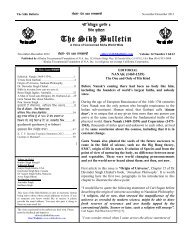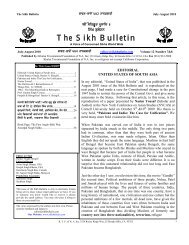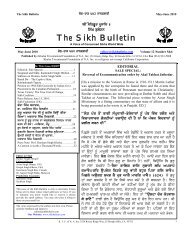Create successful ePaper yourself
Turn your PDF publications into a flip-book with our unique Google optimized e-Paper software.
<strong>The</strong> <strong>Sikh</strong> <strong>Bulletin</strong> vYswK 537 April 2005<br />
<strong>The</strong>se are to love and pray to one God, to read, study and live<br />
according to the <strong>Sikh</strong> teachings, and to help and serve<br />
humanity at large.<br />
Those receiving initiation are then asked if they are willing to<br />
abide by these rules. If they indicate their assent, one of the<br />
five says a prayer for the commencement of the preparation<br />
of the Amrit (Nectar) and a lesson or passage from the Guru<br />
Granth Sahib randomly opened is read. Clean water and<br />
sugar or other soluble sweet is placed in the bowl which must<br />
be of steel. <strong>The</strong> five now position themselves around the<br />
bowl in the bir asan position (kneeling on the right knee with<br />
the weight of the body on the right foot, and the left knee<br />
raised). Having so positioned themselves they commence to<br />
recite the following:<br />
<strong>The</strong> Japji Sahib, Jap Sahib, Ten Svaiyyas (Saravagsudh<br />
vale), Benti Chaupai (from Hamri karo hath dai rachchha to<br />
dusht dokh te leho bachai) and the first five verses and the<br />
last verse of Anandu Sahib.<br />
Anyone who is reciting these prayers should place his left<br />
hand on the edge of the bowl and stir the nectar with a short<br />
sword held in the right hand. <strong>The</strong> others participating in the<br />
ceremony should place both hands on the edge of the bowl<br />
and concentrate and meditate on the nectar. After the<br />
completion of these prayers, one of the five says the ardas,<br />
after which the nectar is served. Only those who have sat<br />
through the whole ceremony may be served. <strong>The</strong> Nectar is<br />
received by those being initiated whilst sitting in the bir asan<br />
position (previously described) with the hands cupped, right<br />
on left, to receive the nectar. This is received five times in the<br />
cupped hands; each time after receiving the nectar, the person<br />
being initiated says "Vahiguru ji ka Khalsa, Sri Vahiguru ji ki<br />
Fateh." This salutation is repeated each time the nectar is<br />
sprinkled on the eyes (5 times) and hair (5 times). <strong>The</strong><br />
remainder of the nectar is then shared by those receiving<br />
initiation, all drinking from the same bowl.<br />
After this, all those taking part in the ceremony recite the<br />
Mul Mantra in unison:<br />
<strong>The</strong>re is one God; His name is truth,<br />
<strong>The</strong> all-pervading Creator,<br />
Without fear, without hatred;<br />
Immortal, unborn, self-existent.<br />
One of the five then details the rules and obligations applying<br />
to the initiates. "From now on your existence as ordinary<br />
individuals has ceased, and you are members of the Khalsa<br />
brotherhood. Your religious father is Guru Gobind Singh<br />
(the tenth and last Guru, founder of the Khalsa brotherhood)<br />
and Sahib Kaur your mother. Your spiritual birthplace is<br />
Kesgarh Sahib (birthplace of the Khalsa) and your home<br />
Anandpur Sahib (the place where Guru Gobind Singh<br />
inaugurated the Khalsa). Your common spiritual parentage<br />
makes you all brothers and you should all forsake your<br />
previous name (surname) and previous local and religious<br />
loyalties. You are to pray to God and God alone, through the<br />
scriptures and teachings of the ten Gurus. You should learn<br />
the Gurmukhi script if you do not know it already and read<br />
daily the Japji, Jap, Das Svaiyye, Sodaru Rahrasi and<br />
Sohila, and should hear or read the Guru Granth Sahib. You<br />
must keep the five K's and are forbidden to:<br />
i) smoke tobacco or take drugs;<br />
ii) eat meat killed by ritual slaughter (i.e. according to<br />
Muslim or Jewish rites);<br />
iii) commit adultery;<br />
iv) cut your hair<br />
Anyone who contravenes any of these rules has broken his<br />
amrit vows. He must go through the ceremony afresh after a<br />
suitable penance if the contravention has been deliberate.<br />
Members of the Khalsa must be always ready to work for<br />
the community and should donate one tenth of their income<br />
for the furtherance of religious or social work.<br />
J) <strong>The</strong> newly initiated <strong>Sikh</strong>s are told not to associate with:<br />
i) the followers of Prithi Chand, Dhir Mall, Ram Rai<br />
or other breakaway groups;<br />
ii) those who actively oppose <strong>Sikh</strong>ism;<br />
iii) those who practise infanticide;<br />
iv) those who take alcohol, tobacco or drugs;<br />
v) those who wed their children for monetary<br />
considerations;<br />
vi) those who perform any rite or ceremony not<br />
sanctioned in <strong>Sikh</strong>ism;<br />
vii) apostate <strong>Sikh</strong>s who do not adhere to the five K's.<br />
k) Ardas is then said and followed by the reading of the<br />
hukam. Finally, any of those present with a name that was<br />
not chosen using the Guru Granth Sahib, are asked to<br />
choose a new name in the customary manner.<br />
<strong>The</strong> ceremony is then concluded with distribution of karah<br />
prasad, which, to emphasize the new brotherhood, is eaten<br />
by those newly initiated from a common plate.<br />
BIBLIOGRAPHY<br />
1. <strong>Sikh</strong> Rahit Maryada. Amritsar, 1975<br />
2. Kuir Singh, Gurbilas Patshahi 10, ed. Shamsher Singh<br />
Ashok. Patiala, 1968<br />
3. Kapur Singh, Pardsaraprasna. Amritsar 1989<br />
4. Cole, W. Owen, and Piara Singh Sambhi, <strong>The</strong> <strong>Sikh</strong>s:<br />
<strong>The</strong>ir Religious Beliefs and Practices. Delhi, 1978<br />
5. Sher Singh, ed.. Thoughts on Symbols in <strong>Sikh</strong>ism. Lahore,<br />
1927<br />
*****<br />
WHICH ‘BANIS’ DID THE TENTH GURU RECITE<br />
AT THE TIME OF ADMINISTERING ‘AMRIT’<br />
-Principal Harbhajan Singh, Satnam Singh-<br />
This information we have culled from Prof. Piara Singh<br />
Padam’s book ‘Rehatnamas’ and from the book on ‘rehat<br />
maryada’ published by the Chief Khalsa Diwan. Here to be<br />
brief, we will mention only different references given about<br />
<strong>The</strong> <strong>Sikh</strong> Center Roseville, 201 Berkeley Ave, Roseville, CA. 95678 5
















